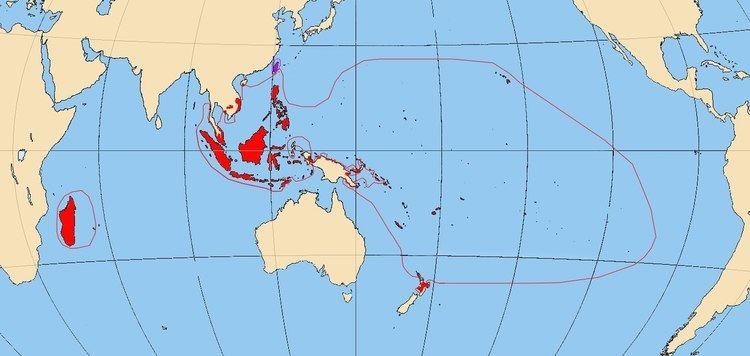 | ||
Austronesia, in historical terms, refers to the homeland of the peoples who speak Austronesian languages, including Indonesian, Malaysian, Filipino, Visayas' Austronesian languages, Ilocano, Maori, Malagasy, Hawaiian, Fijian, Taiwan's Austronesian languages and around a thousand other languages. The Austronesian homeland is thought by linguists to have been prehistoric Taiwan.
Contents
The name Austronesia comes from the Latin austrālis "southern" plus the Greek νήσος (nêsos) "island".
However, in contemporary terminology, the word Austronesia pertains to the regions where Austronesian languages are spoken. Austronesia then covers almost half of the globe, although mostly ocean and oceanic islands, starting from Madagascar to the west until Easter Island, to the east. Austronesia as a region has three traditional divisions: Taiwan (Formosa), the Maritime Southeast Asia, and Austronesian Oceania (Micronesia, Melanesia and Polynesia).
Maritime Southeast Asia
Maritime Southeast Asia covers the modern nations of:
And as well: The Pattani region of Thailand, and the Chamic areas of Vietnam, Cambodia and Hainan Island.
Islands in the vicinity, with native populations having Malay or mixed Malay ancestry, which are not considered part of the Malay Archipelago include New Guinea and the Marianas Islands.
South Asia
Eastern Sri Lanka, well as parts of the Andaman Islands inhabited by the Orang Laut.
Micronesia
The term Micronesia was coined in 1893 by Jules D'Ormont from the Greek roots, meaning 'small islands'.
Politically, Micronesia is divided between eight territories:
Melanesia
The term Melanesia was coined in 1893 by Jules D'Ormont from the Greek meaning 'black islands', in reference to the physiognomy of the Melanesians.
The following islands and groups of islands are traditionally considered part of Melanesia:
Other islands with populations of mixed Melanesian ancestry but are not part of the traditional Melanesian area include:
Polynesia
The term Polynesia was coined in 1756 by Charles de Brosses from the Greek meaning "many islands", describing the multiplicity of the islands in this area of the Pacific.
Countries and territories traditionally included in Polynesia include:
In addition to these islands in this mid-Pacific ocean, Polynesia often is meant to include the Polynesian outliers: islands that are culturally or linguistically Polynesian, but that are geographically in Melanesia or Micronesia. Most of these are small or isolated islands, like Rennell or Tikopia in the Solomon Islands.
